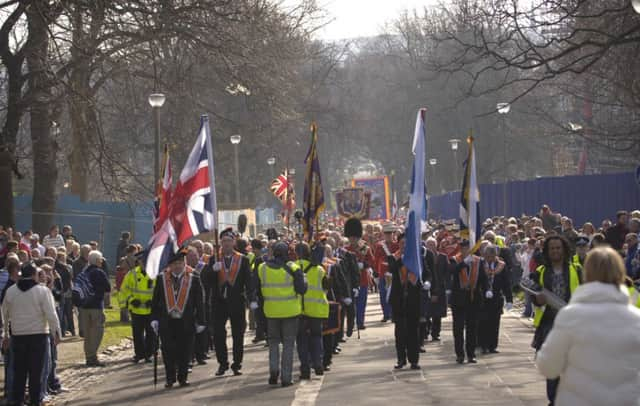Peter Geoghegan: ‘Yes’ impact on Irish relations


JUST 12 miles separate Scotland and Ireland at the shortest point. Some days the distance across the Straits of Moyle between the Mull of Kintyre and Fair Head can feel like a mere hop; at other times, the two lands can feel worlds apart.
This has particularly been the case during the independence referendum. Thousands of Northern Irish Orangemen are expected to descend on Edinburgh for a massive parade next Saturday, much to the chagrin of some unionists.
Advertisement
Hide AdAdvertisement
Hide AdScottish nationalists blithely cite Ireland as a model of how to sever a British union, but rarely think through the lessons on everything from sovereignty and citizenship to currency and border controls to be learned from post-1922 Ireland.
Across the Irish Channel, the response to Scotland’s great debate has been mixed. In Northern Ireland, nationalists have been muted about the possibility of the break-up of Britain. Some excitable unionists have warned that a Yes in Edinburgh could spark a return to violence on the streets of Belfast. In Dublin, government ministers have been told to remain studiously neutral on “the Scottish Question”.
Little has been said, however, about how the referendum might radically transform relations with Ireland, north and south – whatever the result.
Would a change in Scotland’s constitutional set-up really push identities further apart across these islands? Or could the Scottish referendum provide an opportunity to give “the Celtic Fringe” a modern restyling?
The idea of an informal “Celtic Alliance” encompassing Scotland and Ireland, north and south, is not as revolutionary as it might sound. The sixth century kingdom of Dalriada stretched from Argyll to Antrim. It was, in the words of Neal Ascherson, “a Gaelic-speaking Atlantic world connected rather than divided by the sea”.
The movement of people, and ideas, between Scotland and Ireland did not end with the Dalriada. The Ulster Plantations were a largely Scottish affair. Between 1650 and 1700, anywhere between 60,000 and 100,000 Scots travelled across the narrow stretch of clear blue water to start a new life.
This migration was not one way. Hundreds of thousands of Irish Catholics came to Scotland from the early 1800s. The naked bigotry they faced is largely a thing of the past, but the Irish Catholic community still occupies a unique – and at times uncomfortable – place in Scottish society. The votes of Catholics of Irish descent in Scotland could prove decisive, a point not lost on Better Together campaigners anxious about the effects of an Orange Order parade through central Edinburgh just days before polls open. (Many Irish Protestants left for Scotland in the 18th and 19th centuries, too; the Orange Order here draws its support in large part from descendants of these emigrants).
Advertisement
Hide AdAdvertisement
Hide AdScotland and Ireland were pushed further apart amid the political and economic tumult of the 19th and 20th centuries. But even then, there were figures who embraced similarity instead of difference. John Ferguson, a Protestant Ulsterman, was very active in the Irish National Land League in Glasgow; in 1913, Scottish Presbyterian Douglas Hogg stood in a by-election in Derry City on a Home Rule platform.
Such connections between Scotland, Ireland and Ulster extend beyond the urban. Poet Sorley MacLean envisaged Gaelic Scotland and Ireland as part of a single cultural continuity. Now, thanks to a vibrant arts scene, and increased public support, Irish and Scottish Gaelic are arguably closer now than at any time since the 1940s. At the same time, Scots speakers have often been involved in the Ulster Scots movement. Could Dublin and Edinburgh learn from this rapprochement?
Restive Ulster, too, is not the thorn in the Celtic side it once was. The Good Friday Agreement was “hugely influential” on theSNP, showing the party what could be achieved by moderation and pragmatism.
The success of the SNP also reflects the decline of once powerful stories of British identity. Scotland and Ulster have a very different relationship with the idea of Britain. For most Catholics in Ireland, Britishness is something foreign, to be disavowed; for Ulster Protestants it is constitutive. For most Scots, however, the relationship has become transactional. Scotland will be a different place whatever way the vote goes. A No result could have almost as significant repercussions for Northern Ireland as independence. Deeper devolution for Scotland would surely spell the end of the Barnett formula – and with that a possible reduction in the block grant to the Stormont assembly. This, more than republican dreams of a border poll, would create real difficulties for a power-sharing government in Belfast that struggles to reach agreement on even the most basic of policies.
A new settlement for Scotland would pose practical questions for the Republic, too. Alex Salmond’s arc of prosperity quip has been overplayed but the SNP has made no secret of its desire to compete with Dublin on corporation tax. Scotland could look to usurp the Irish as the cuddly Celts on the edge of Europe.
But political change in Scotland might also be an opportunity to re-think relations beyond the centripetal pull of London. Perhaps the time has finally come for Scotland to forge a different relationship with Ireland, drawing on cultural reserves that unite rather than divide us.
In practical terms, this would require investment in links between Edinburgh, Dublin and Belfast – and Oban, Letterkenny and Ballycastle – as a matter of policy, not vague intent.
l Peter Geoghegan is an Irish writer and journalist based in Glasgow